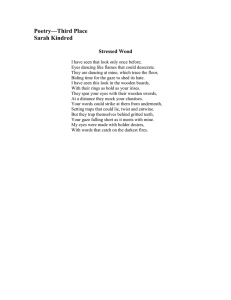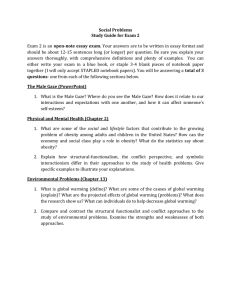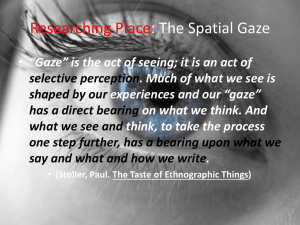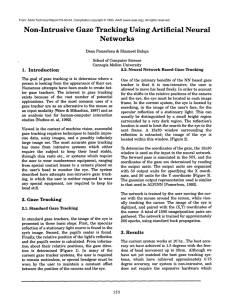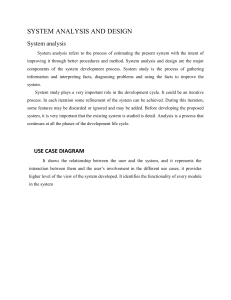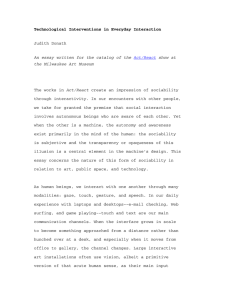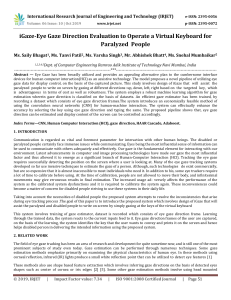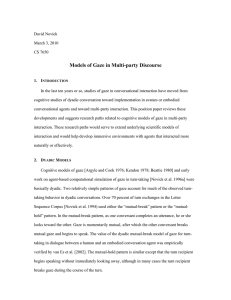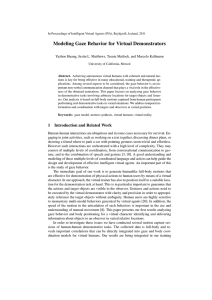Document 13509086
advertisement
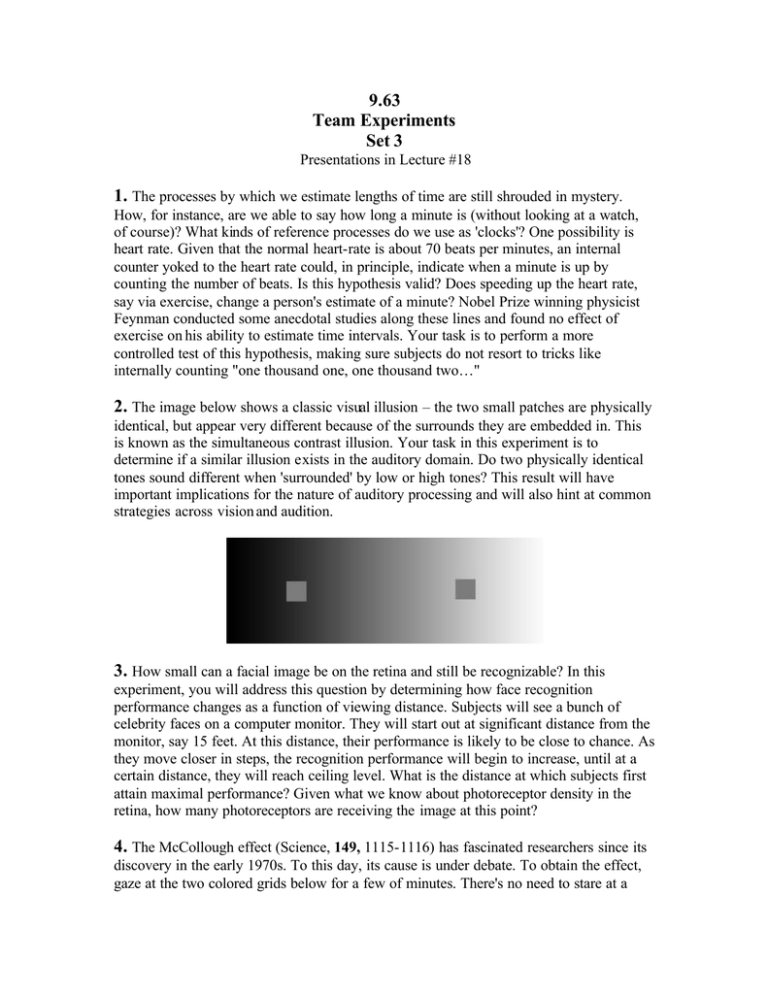
9.63 Team Experiments Set 3 Presentations in Lecture #18 1. The processes by which we estimate lengths of time are still shrouded in mystery. How, for instance, are we able to say how long a minute is (without looking at a watch, of course)? What kinds of reference processes do we use as 'clocks'? One possibility is heart rate. Given that the normal heart-rate is about 70 beats per minutes, an internal counter yoked to the heart rate could, in principle, indicate when a minute is up by counting the number of beats. Is this hypothesis valid? Does speeding up the heart rate, say via exercise, change a person's estimate of a minute? Nobel Prize winning physicist Feynman conducted some anecdotal studies along these lines and found no effect of exercise on his ability to estimate time intervals. Your task is to perform a more controlled test of this hypothesis, making sure subjects do not resort to tricks like internally counting "one thousand one, one thousand two…" 2. The image below shows a classic visual illusion – the two small patches are physically identical, but appear very different because of the surrounds they are embedded in. This is known as the simultaneous contrast illusion. Your task in this experiment is to determine if a similar illusion exists in the auditory domain. Do two physically identical tones sound different when 'surrounded' by low or high tones? This result will have important implications for the nature of auditory processing and will also hint at common strategies across vision and audition. 3. How small can a facial image be on the retina and still be recognizable? In this experiment, you will address this question by determining how face recognition performance changes as a function of viewing distance. Subjects will see a bunch of celebrity faces on a computer monitor. They will start out at significant distance from the monitor, say 15 feet. At this distance, their performance is likely to be close to chance. As they move closer in steps, the recognition performance will begin to increase, until at a certain distance, they will reach ceiling level. What is the distance at which subjects first attain maximal performance? Given what we know about photoreceptor density in the retina, how many photoreceptors are receiving the image at this point? 4. The McCollough effect (Science, 149, 1115-1116) has fascinated researchers since its discovery in the early 1970s. To this day, its cause is under debate. To obtain the effect, gaze at the two colored grids below for a few of minutes. There's no need to stare at a single point on a grid. If you now look at the purely black-and-white grid below the colored grids, you should notice a green haze around the horizontal lines, and a magenta haze around the vertical lines. Adapting (or 'training') pattern. Test pattern. One interesting issue is whether the sub strates underlying this effect are early (retinal) as for many other aftereffects, or more central. Experiments probing whether the McCollough effect transfers from the adapted to the unadapted eye have found almost no such transfer, suggesting an early locus of the effect. This experiment is an attempt to further probe this issue. You will adapt your subjects separately for each eye. The left eye will be adapted with a pattern showing vertical bars superimposed on a magenta background while the right eye will see the same set of vertical bars on a green background. We expect that after adaptation, the left eye when separately shown just the black and white vertical grating will see a green haze and the right eye separately will see a red haze. The question you will probe is what happens when both eyes look at a black and white vertical grating simultaneously. Does this lead to binocular rivalry (alterations of perceived color over time) or canceling of colors or something completely unexpected. Based on the results, you will draw inferences regarding the locus of the McCollough effect. 5. How do we represent sounds in order to recognize them? For instance, when taking a walk near a lake, how do you recognize a sound to be a quack of a duck and another to be the chirp of a frog? One extreme possibility is that we encode sounds as collections of little snippets, without worrying too much about the temporal order of these snippets. It is quite likely that this hypothesis is too simple minded to be correct – temporal order seems to be quite important for auditory recognition. However, it is still interesting to ask how much can we accomplish even when the temporal order is incorrect? This experiment investigates this question. Your task will be to collect a set of sound clips from the web or CD ROMs. You will then reverse these sound files to play them backwards (easily done in Matlab). You will determine how accurate listeners are at identifying these sounds relative to their accuracy with the non-reversed sounds. 6. In class, we have talked about regression analysis and how we can analytically fit a line that best summarizes the linear relationship in a scatterplot. In this experiment, you will assess how well human subjects can do this task just by 'eyeballing' the scatterplot. In other words, how close in terms of slope is the line they suggest to the actual regression line calculated using the techniques we have talked about? Furthermore, how does the accuracy of subjects change as a function of the coefficient of correlation and outliers in the scatterplot. You will generate several synthetic scatterplots for which you will know the actual regression line slope and r. For each of these scatterplots, your subjects will draw a line they think best fits the data. You will then compare the slope of this line to the actual one and assess changes in accuracy across r and number of outliers. 7. Humans are very good at estimating gaze direction. However, the precise strategies they use to do so are still unclear. Specifically, it is not known how information is combined across the two eyes in the stimulus face. In other words, when you see me looking sideways, you are getting information from both of my eyes. How is this information combined especially when the gaze direction estimates from the two eyes independently are not the same (as happens when the gaze direction is not exactly frontal or extremely sideways). You will use a set of eye pairs (synthetic or real) with the gaze directions for each eye in a pair varied independently. The subject will tell you his/her estimate of the gaze direction when shown each eye independently and when shown both eyes together. How is the latter gaze estimate derived from the independent eye-based gaze estimates? Is there a simple formula that connects these quantities together?

